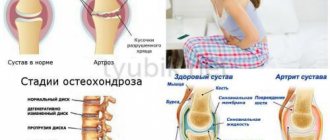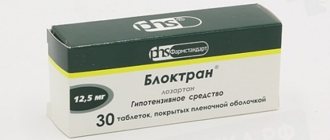Faspik, 6 pcs., 400 mg, film-coated tablets
From the gastrointestinal tract:
NSAID gastropathy (abdominal pain, nausea, vomiting, heartburn, loss of appetite, diarrhea, flatulence, constipation; rarely - ulceration of the gastrointestinal mucosa, which in some cases is complicated by perforation and bleeding); irritation or dryness of the oral mucosa, pain in the mouth, ulceration of the gum mucosa, aphthous stomatitis, pancreatitis.
From the hepatobiliary system:
hepatitis.
From the respiratory system:
shortness of breath, bronchospasm.
From the senses:
hearing impairment (hearing loss, ringing or tinnitus).
From the central and peripheral nervous system:
headache, dizziness, insomnia, anxiety, nervousness and irritability, psychomotor agitation, drowsiness, depression, confusion, hallucinations, rarely - aseptic meningitis (more often in patients with autoimmune diseases).
From the cardiovascular system:
heart failure, tachycardia, increased blood pressure.
From the urinary system:
acute renal failure, allergic nephritis, nephrotic syndrome (edema), polyuria, cystitis.
Allergic reactions:
skin rash (usually erythematous or urticarial), pruritus, angioedema, anaphylactoid reactions, anaphylactic shock, bronchospasm or dyspnea, fever, erythema multiforme exudative (including Stevens-Johnson syndrome), toxic epidermal necrolysis (Lyell's syndrome), eosinophilia, allergic rhinitis.
From the hematopoietic organs:
anemia (including hemolytic, aplastic), thrombocytopenia and thrombocytopenic purpura, agranulocytosis, leukopenia.
From the organs of vision:
toxic damage to the optic nerve, blurred vision or double vision, scotoma, dryness and irritation of the eyes, swelling of the conjunctiva and eyelids (allergic origin).
The risk of developing ulcerations of the gastrointestinal mucosa, bleeding (gastrointestinal, gingival, uterine, hemorrhoidal), visual impairment (impaired color vision, scotoma, damage to the optic nerve) increases with long-term use of the drug in large doses.
Changes in laboratory parameters:
bleeding time (may increase); serum glucose concentration (may decrease); creatinine clearance (may decrease); hematocrit or hemoglobin (may decrease); serum creatinine concentration (may increase); activity of “liver” transaminases (may increase).
Faspik granules for solution apricot 400 mg 12 pcs
The effectiveness of furosemide and thiazide diuretics may be reduced due to sodium retention associated with inhibition of renal prostaglandin synthesis. Strengthens the effect of indirect anticoagulants, antiplatelet agents, fibrinolytics (increasing the risk of hemorrhagic complications). When administered simultaneously with acetylsalicylic acid, ibuprofen reduces its antiplatelet effect (possibly increasing the incidence of acute coronary insufficiency in patients receiving small doses of acetylsalicylic acid as an antiplatelet agent). Reduces the hypotensive activity of vasodilators (including slow calcium channel blockers and ACE inhibitors). Isolated cases of increased plasma concentrations of digoxin, phenytoin and lithium while taking ibuprofen have been described in the literature. Agents that block tubular secretion reduce excretion and increase plasma concentrations of ibuprofen. Faspik (like other NSAIDs) should be used with caution in combination with acetylsalicylic acid or other NSAIDs (this increases the risk of adverse effects of the drug on the gastrointestinal tract). Faspik may increase plasma concentrations of methotrexate. Combination treatment with zidovudine and Faspic may increase the risk of hemarthrosis and hematoma in HIV-infected patients with hemophilia. The combined use of Faspic and tacrolimus may increase the risk of nephrotoxicity due to a reduction in the synthesis of prostaglandins in the kidneys. Ibuprofen enhances the hypoglycemic effect of oral hypoglycemic agents and insulin; Dose adjustment may be necessary. An ulcerogenic effect with bleeding has been described when combined with colchicine, estrogens, ethanol, and glucocorticosteroids. Antacids and cholestyramine reduce the absorption of ibuprofen. Caffeine enhances the analgesic effect. When prescribed with anticoagulant and thrombotic agents (alteplase, streptokinase, urokinase), the risk of bleeding simultaneously increases. Cefamandole, cefaperazone, cefotetan, valproic acid, plicamycin increase the incidence of hypoprothrombinemia. Myelotoxic enhance the manifestations of hematotoxicity of the drug. Cyclosporine and gold preparations enhance the effect of ibuprofen on the synthesis of prostaglandin in the kidneys, which is manifested by increased nephrotoxicity. Ibuprofen increases the plasma concentration of cyclosporine and the likelihood of developing its hepatotoxic effects. Inducers of microsomal oxidation (phenytoin, ethanol, barbiturates, rifampicin, phenylbutazone, tricyclic antidepressants) increase the production of hydroxylated active metabolites, increasing the risk of severe hepatotoxic reactions. Microsomal oxidation inhibitors reduce the risk of hepatotoxicity.
Faspik tablets 400 mg No. 6
Compound
1 table contains ibuprofen 400 mg, excipients: L-arginine, sodium bicarbonate, crospovidone, magnesium stearate, hypromellose, sucrose, titanium dioxide, macrogol 400
Pharmacokinetics
Faspik has analgesic, antipyretic, and anti-inflammatory effects.
NSAIDs. Ibuprofen, the active substance of the drug Faspik, is a derivative of propionic acid and has analgesic, antipyretic and anti-inflammatory effects due to the non-selective blockade of COX-1 and COX-2, as well as an inhibitory effect on the synthesis of prostaglandins.
The analgesic effect is most pronounced for inflammatory pain. The analgesic activity of the drug is not of the opioid type.
Like other NSAIDs, ibuprofen has antiplatelet activity.
The analgesic effect when using the drug Faspik develops 10-45 minutes after its administration.
Indications for use
- elevated temperature in various inflammatory diseases
- mild to moderate pain
- rheumatic diseases.
Contraindications
- peptic ulcer of the stomach and duodenum
- attacks of bronchial asthma
- hypersensitivity to the drug, headache, dizziness, blood picture disturbances.
Directions for use and doses
The daily dose of Faspik when taken orally is 0.6-1.2 g in 3-4 doses, the drug is also used rectally in suppositories and externally as an ointment.
Children are prescribed 20-40 mg per kg of body weight per day.
Storage conditions
At a temperature not exceeding 40 C
Best before date
2 years
special instructions
Use with caution in patients with liver and kidney diseases.
Long-term use of Faspik without consulting a doctor is not recommended.
Side effects
- nausea, abdominal pain, bloating, stool disorders
- gastrointestinal bleeding
- renal failure
- abnormal blood picture
- skin rash.
Use during pregnancy and breastfeeding
Contraindicated in children under 12 years of age.
The drug is contraindicated for use during pregnancy and lactation (breastfeeding).
The use of Faspik may adversely affect female fertility and is not recommended for women planning pregnancy.
Interaction
The effectiveness of furosemide and thiazide diuretics may be reduced due to sodium retention associated with inhibition of renal prostaglandin synthesis.
Faspik may enhance the effect of oral anticoagulants, so simultaneous use is not recommended.
When administered simultaneously with acetylsalicylic acid, ibuprofen reduces its antiplatelet effect (an increase in the incidence of acute coronary insufficiency in patients receiving small doses of acetylsalicylic acid as an antiplatelet agent is possible).
Faspik may reduce the effectiveness of antihypertensive drugs.
Isolated cases of increased plasma concentrations of digoxin, phenytoin and lithium while taking ibuprofen have been described in the literature.
Faspik (like other NSAIDs) should be used with caution in combination with acetylsalicylic acid or other NSAIDs and corticosteroids (this increases the risk of adverse effects of the drug on the gastrointestinal tract).
Faspik may increase plasma concentrations of methotrexate.
Combination treatment with zidovudine and Faspic may increase the risk of hemarthrosis and hematoma in HIV-infected patients with hemophilia.
The combined use of Faspic and tacrolimus may increase the risk of nephrotoxicity due to a reduction in PG synthesis in the kidneys.
Ibuprofen enhances the hypoglycemic effect of oral hypoglycemic agents and insulin; dose adjustment may be necessary.
Overdose
Symptoms: abdominal pain, nausea, vomiting, lethargy, drowsiness, depression, headache, tinnitus, metabolic acidosis, coma, acute renal failure, decreased blood pressure, bradycardia, tachycardia, atrial fibrillation, respiratory arrest.
Treatment: gastric lavage (only within an hour after administration), administration of activated charcoal, alkaline drinking, forced diuresis, symptomatic therapy (correction of acid-base status, blood pressure).
Description of the drug FASPIC
With simultaneous use, ibuprofen reduces the effect of antihypertensive drugs (ACE inhibitors, beta-blockers), diuretics (furosemide, hydrochlorothiazide).
When used simultaneously with anticoagulants, their effect may be enhanced.
When used simultaneously with GCS, the risk of side effects from the gastrointestinal tract increases.
When used simultaneously, ibuprofen can displace indirect anticoagulants (acenocoumarol), hydantoin derivatives (phenytoin), and oral hypoglycemic drugs, sulfonylurea derivatives, from compounds with blood plasma proteins.
When used simultaneously with amlodipine, a slight decrease in the antihypertensive effect of amlodipine is possible; with acetylsalicylic acid - the concentration of ibuprofen in the blood plasma decreases; with baclofen - a case of increased toxic effects of baclofen has been described.
When used simultaneously with warfarin, an increase in bleeding time is possible; microhematuria and hematomas were also observed; with captopril - the antihypertensive effect of captopril may be reduced; with cholestyramine - a moderate decrease in the absorption of ibuprofen.
When used simultaneously with lithium carbonate, the concentration of lithium in the blood plasma increases.
When used simultaneously with magnesium hydroxide, the initial absorption of ibuprofen increases; with methotrexate - the toxicity of methotrexate increases.
The simultaneous use of NSAIDs and cardiac glycosides can lead to worsening heart failure, a decrease in glomerular filtration rate and an increase in the concentration of cardiac glycosides in the blood plasma.
There is evidence of the likelihood of an increase in the concentration of methotrexate in the blood plasma during the use of NSAIDs.
With simultaneous use of NSAIDs and cyclosporine, the risk of nephrotoxicity increases.
NSAIDs may reduce the effectiveness of mifepristone, so taking NSAIDs should be started no earlier than 8-12 days after stopping mifepristone.
Concomitant use of NSAIDs and tacrolimus may increase the risk of nephrotoxicity.
Concomitant use of NSAIDs and zidovudine may lead to increased hematotoxicity. There is evidence of an increased risk of hemarthrosis and hematomas in HIV-positive patients with hemophilia who received concomitant treatment with zidovudine and ibuprofen.
In patients receiving concomitant treatment with NSAIDs and quinolone antibiotics, the risk of seizures may increase.
In patients receiving concomitant NSAIDs and myelotoxic drugs, hematotoxicity increases.
With the simultaneous use of ibuprofen and cefamandole, cefoperazone, cefotetan, valproic acid, plicamycin, the incidence of hypoprothrombinemia increases.
With the simultaneous use of ibuprofen and drugs that block tubular secretion, there is a decrease in excretion and an increase in plasma concentration of ibuprofen.
With the simultaneous use of ibuprofen and inducers of microsomal oxidation (phenytoin, ethanol, barbiturates, rifampicin, phenylbutazone, tricyclic antidepressants), there is an increase in the production of hydroxylated active metabolites and an increased risk of developing severe intoxications.
Faspik
The effectiveness of furosemide and thiazide diuretics may be reduced due to sodium retention associated with inhibition of renal prostaglandin synthesis. Strengthens the effect of indirect anticoagulants, antiplatelet agents, fibrinolytics (increasing the risk of hemorrhagic complications). When administered simultaneously with acetylsalicylic acid, ibuprofen reduces its antiplatelet effect (possibly increasing the incidence of acute coronary insufficiency in patients receiving small doses of acetylsalicylic acid as an antiplatelet agent). Reduces the hypotensive activity of vasodilators (including slow calcium channel blockers and ACE inhibitors). Isolated cases of increased plasma concentrations of digoxin, phenytoin and lithium while taking ibuprofen have been described in the literature. Agents that block tubular secretion reduce excretion and increase plasma concentrations of ibuprofen. Faspik (like other NSAIDs) should be used with caution in combination with acetylsalicylic acid or other NSAIDs (this increases the risk of adverse effects of the drug on the gastrointestinal tract). Faspik may increase plasma concentrations of methotrexate. Combination treatment with zidovudine and Faspic may increase the risk of hemarthrosis and hematoma in HIV-infected patients with hemophilia. The combined use of Faspic and tacrolimus may increase the risk of nephrotoxicity due to a reduction in the synthesis of prostaglandins in the kidneys. Ibuprofen enhances the hypoglycemic effect of oral hypoglycemic agents and insulin; Dose adjustment may be necessary. An ulcerogenic effect with bleeding has been described when combined with colchicine, estrogens, ethanol, and glucocorticosteroids. Antacids and cholestyramine reduce the absorption of ibuprofen. Caffeine enhances the analgesic effect. When prescribed with anticoagulant and thrombotic agents (alteplase, streptokinase, urokinase), the risk of bleeding simultaneously increases. Cefamandole, cefaperazone, cefotetan, valproic acid, plicamycin increase the incidence of hypoprothrombinemia. Myelotoxic enhance the manifestations of hematotoxicity of the drug. Cyclosporine and gold preparations enhance the effect of ibuprofen on the synthesis of prostaglandin in the kidneys, which is manifested by increased nephrotoxicity. Ibuprofen increases the plasma concentration of cyclosporine and the likelihood of developing its hepatotoxic effects. Inducers of microsomal oxidation (phenytoin, ethanol, barbiturates, rifampicin, phenylbutazone, tricyclic antidepressants) increase the production of hydroxylated active metabolites, increasing the risk of severe hepatotoxic reactions. Microsomal oxidation inhibitors reduce the risk of hepatotoxicity.


